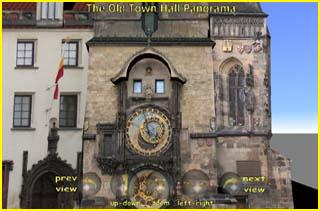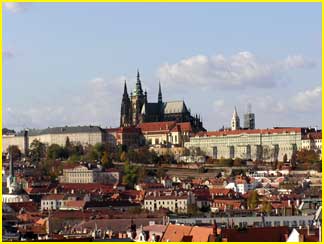
-
David Antonín
(antonid@fel.cvut.cz) -
Martin Krahulík
(krahum1@fel.cvut.cz) - Oto Válek
(valeko@fel.cvut.cz)
In Prague, 4.1.2004
 |
Team members:
In Prague, 4.1.2004 |
Introduction:
The goal of the Virtual Heart of Central Europe project is to show the beauty
of Prague and current possibilities of modern communications technology.
Our effort in this project was to create models of both the exterior and the interior of the Old Town Hall with fotorealistic textures and audio record of the Astronomical Clock (Orloj). We were also to create a multimedial presentation containing panoramic photography from the top of the tower, zooms to the attractive visible buildings in video format (.avi) and historical and technical informations about the hall.
Getting data:
Our basic source for making both models were photographs taken with digital
cameras. Most of them have minimal zoom to enable reasonable calibration and
consequential making models.
Audio record was taken with digital minidisc recorder. It was important to turn off automatical adjusting of the sound level during recording.
The internet, books and plans of the building privided us with the historical and technical information.
Processing of the data:
Models:
At first, we used the program Image Modeller Light to create basic parts of
the models. This was to guarantee keeping of proportions among objects. We also
made some additional textures which were difficult to get from the street-level view.
Unfortunately, this way we could produce only
some objects because we weren't able to calibrate two sets of photographs taken
with different cameras. We modified and simplified the resulting models using 3D Studio
Max to make them showy and fast to render.
 |
 |
| Exterior of the hall (links to a video) | Sightseeing room on the top of the tower (links to a video) |
Sound:
When taking an audio record, it was nessesary to eliminate, as much as possible,
noises like voices of people, wind, locking doors of the hall etc. Unfortunately,
twelve apostles
march along the windows only from 9 am. to 9 pm, when there are many people
crowding the Old town square. The Goldwave application was used for noise reduction. Quality
of a result is partially limited by a large spectrum of frequencies produced
by bells (including those ones emitted by people). When there are some of them
stifled, it makes a large difference on the sound output.
QuickTime VR panorama:
Panoramic picture of the Prague was created by pasting photographs taken
on the gallery of the tower together. As it is noticeable from the picture,
good visibility and weak wind is desired to avoid scene changes
during photograph taking. If no tripod is used it's necessary
to rotate photographs and fill in the missing parts of the sky. Each photograph
is taken during different light conditions (in a shade of the building,
against the sun, etc.), therefore it's essential to modify its brightness and
contrast to avoid visible edges in the resulting picture. The Adobe Photoshop
served succesfully for these modifications. Resulting
panorama was created using the Panorama Factory application.
 |
| Prague's Panorama from the top of the tower |
Video:
There are two types of the videos in the presentation. Some containing zooms to the
interesting buildings visible from the top of the tower and two synthetic videos
with zooms from the Petřínská rozhledna and the Žižkov TV Tower. The first
type was taken by videocamera in bad visibility conditions. Even after increase of
a contrast we couldn't stifle fog. The second type was made mingling three pictures
with different zoom levels. We found Sonic Foundry Vegas suitable for its creation.
 |
 |
| Real video | Synthetic video |
Text:
In the text, written both in Czech and in English, we have described a history of
the Old Town Hall - gradual construction of it's buildings and their architecture
as well as historical events connected to hall. A part of the text is dedicated
to the Astronomical clock and legends about it. Finallly there is a summary of
the most important historic dates, technical information from the architectural
plans and turist information about opening hours and avaible tours.
It's quite difficult to define a part of the text which we have written ourselves. The text is a compilation from several sources (see references) merged with information from the plans of the building, internet resources and information available in the Hall itself. The resulting text was translated to English.
Estimation of time demands (if we did it with current knowledge):
| Activity | Solvers | ||
| David Antonín | Martin Krahulík | Oto Válek | |
| Photographing the hall | 3hr | 3hr (5 sessions) | 3hr |
| Panoramatic QuickTimeVR from the top of the tower | 2hr | - | |
| Videos | 3hr | - | |
| Plans of the building | 5hr (4 archive visits) | ||
| 3D model - Image Modeller | 40hr | 8hr | |
| 3D model - 3D Studio Max | 5hr | 10hr | 50hr |
| Editing the textures | 4hr | 25hr | 7hr |
| VRML | 5hr | - | 5hr |
| Sound | 5hr | ||
| Text and language correction | 12hr | 2hr | |
| SUM | 62hr | 126hr | 67hr |
References:
Conclusion:
We have created two 3D models (interior and exterior) in 3D Studio Max and
corresponding VRML models, QuickTimeVR panorama of Prague, several types
of videos, audio record and the text about the Hall. During this work we
have learned to reconstruct a 3D model from 2D photographs using the program Image
Modeller Light, modeling in 3D Studio Max, basics of VRML, editing a real
video and sound and adjusting images for panoramatic photographs and synthesis of
videos from them.
This was a first work on a real project for some members of the team. We lived through some problems of such work and were overcoming some troubles in communication among teams.
Despite partial troubles and the fact that we were learning most of the skills during the work we have successfully finished the task and we think that work on this project was a great benefit for us.